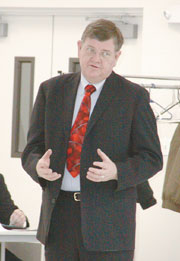|
Sublette Examiner Volume 3, Number 51 - March 18, 2004 brought to you online by Pinedale Online
by Cat Urbigkit The first meeting of the Wyoming Brucellosis Coordination Team appointed by Wyoming Governor Dave Freudenthal convened Wednesday morning at the Pinedale Entertainment Center. About 30 people, including task force members and technical people, gathered around tables to begin the process of tackling the brucellosis issue in wildlife and livestock in the state. The crowd gathered to watch and listen numbered only about 20, mostly local cattle producers and agency personnel. Freudenthal addressed the group, thanking everyone for being involved, explaining that each person he talked to either expressed reservations about being involved or about the group's prospects for success. Freudenthal talked about the myriad problems that are all interconnected with this issue, and noted it all appears to be coming to a head in this region. Freudenthal asked the task force to look at helping resolve not just the short-term brucellosis crisis in which the state has lost its brucellosis class-free status, but also at the long-term situation. Freudenthal likened brucellosis in Wyoming to a fire burning under the surface, flaring up on the surface on occasion. He said it should be acknowledged that it's not a question of what if, but when, brucellosis will occur in the state. "Are there things that need to change in the state in terms of interaction between wildlife and livestock?" he asked the group to consider. The task force is to look at how the state should respond to current issues, as well as the longer-term policy issues and "what are we going to do in the long-term to address this." "It's simply not going to go away," Freudenthal said, noting that he structured the group so that neither the state ag department or wildlife agency would serve as the chair, instead selecting the University of Wyoming's ag college dean to serve in that position, "so there would not be an automatic assumption about the outcome." Freudenthal urged the group to be very specific with its recommendations and to set their interest groups aside and, instead, work with their own expertise. Freudenthal predicted that those that have been appointed to the task force have already received calls from people with various interests in the issue, explaining what they think the task force should do to address the issue. Freudenthal said that since announcing the appointments, for each person appointed, he probably had 15 people call to tell him either "that was a good or bad appointment." Some e-mails accused Freudenthal of planning a program to hurry the closure of the elk feedgrounds in western Wyoming, while others took the opposite view, that he planned to leave the feedgrounds intact forever, he said. "I'm passing the hotseat on to you guys," he said. Freudenthal said he is "a bit cynical" about the Greater Yellowstone Interagency Brucellosis Committee and its effectiveness, suggesting that the group is "not specific enough" in its recommendations. As for the timeline of the task force, Freudenthal suggested that it present any recommendations that need legislative action shortly after the November election so the process can begin for the January 2005 legislative session. He said the life of the task force would be at least a year, noting that he plans to make the state airplane available for those having to travel long distances to meetings. Freudenthal also cautioned, "For this thing to be credible, you've got to make sure that you let the public talk, at every meeting." The task force is structured so that there is a public comment period at the closing of each meeting. He reminded the group: "You have a public obligation," suggesting that if the group wants to get anything implemented, it has to be understood by the public. The brucellosis issue flared in late November when a herd of cattle in the Boulder area was found to be infected. The herd was depopulated and an intensive testing program for regional cattle initiated, but when a second herd, originating from the original infected herd, was found on a Worland feedlot, Wyoming lost its brucellosis class-free status. The Boulder herd was in close contact with elk using the nearby Muddy Creek elk feedground. Several elk from that feedground were subsequently tested and found to be carriers of the disease. Donal O'Toole of the Wyoming State Veterinary Laboratory said his lab is still waiting to see how close the cattle isolates matched the elk isolates. The testing is being conducted at a federal lab in Iowa. Because brucellosis is a significant zoonotic disease, it has been identified as a select agent by the Centers for Disease Control, according to Dr. Ken Mills of the Wyoming State Veterinary Laboratory. Because it's a select agent, dealing with it is expensive. Mills said development of a new vaccine could easily cost $500,000, and vaccine trials would cost another $500,000, without any guarantee of success. The next meeting of the task force is slated for April 8 in Lander. The group will convene in Pinedale again in May, in a session held in conjunction with the Greater Yellowstone Interagency Brucellosis Committee. The GYIBC will meet May 18 and 19, with the task force meeting set for May 20. See The Archives for past articles. Copyright © 2002, 2003, 2004 Sublette Examiner All rights reserved. Reproduction by any means must have permission of the Publisher. Sublette Examiner, PO Box 1539, Pinedale, WY 82941 Phone 307-367-3203 examiner@wyoming.com |

